Stable to Table: Recipes from a Lifetime of Travel, Riding and Cooking
A new cookbook pairs Dawn Harris Brown’s equestrian culinary adventures with stunning horse photos from her travels.
by Karen Braschayko
Dawn Harris Brown has ridden and cooked her way across the world. Traveling by horseback through lands as exotic as Mongolia, the Australian outback and Hungary, she gathered recipes along the way, and she’s now sharing them with us in the Stable to Table Menu Cookbook.
Brown combines her decades of riding adventures in far-off locations with her culinary experiences as a chef. She learned about foods by cooking them in their land of origin, from fish cakes in Denmark to arepas in Colombia. She has attended cooking schools in France, the United States, England, Australia, Canada, Southeast Asia and Morocco.
.jpg)
Dawn Harris Brown
Trying out her recipes was a pleasure. Brown’s dishes are my kind of food — simple but gourmet combinations of whole ingredients, many of which I already had in my pantry or could find at any grocery store. Fresh herbs brighten the recipes, and the photos of beautiful horses reminded me how hungry I get when I ride. If you sometimes waver on what foods and drinks to pair together, Brown combines them for you with a menu format that removes the questions and balances the flavors.
Several recipes made it into my favorites file. If you like nuts, spend five minutes making “Winner’s Spicy Pecans.” I ate so many that I had to call it dinner. I made “Kris’s Apple Cake” for my mother’s birthday. It took less than 10 minutes to mix the batter, and my family raved about it. “Austrian Potato Salad” was a simple, perfect side dish. I particularly enjoyed her fresh take on the Kentucky Hot Brown, which she calls her “Kentucky Hot Mrs. Brown.” She adds asparagus, which is fitting since the Kentucky Derby runs at the height of asparagus season, and swaps in nutty, smooth-melting gruyere for the cheese sauce.
Here, Brown shares some fascinating stories from her lifetime of riding and eating and how she was inspired to combine her passions into a cookbook.
Karen Braschayko for Equitrekking: When did you start riding and fall in love with horses?
Dawn Harris Brown: “The greatest pleasure in life is doing what people say you cannot do.” - Walter Bagehot
I was born and raised in Texas into a ranching family. Horses and cattle were a big part of my life. My father raised polo ponies and played polo for over 50 years. I don’t remember ever starting to ride. It was just understood — “If she can walk, she can ride!” Being the last of four children, I just had to keep up on the family rides. We always had plenty of polo ponies that needed exercising and training. We rode them first to do ranch work before they ever saw a polo field. As a teenager, I was one of the few women players.
.jpg)
Equitrekking: When did you start connecting cooking to riding?
Dawn Harris Brown: My first culinary influences were barbeque and Mexican food. My love of food started with my family’s large ranch barbeques. Ranchers and friends came from all over the Texas Hill Country every Sunday for barbequed cabrito, or young goat. We also had Mexican pinto beans, tortillas, salsas and salads. In Stable to Table Menu Cookbook, I included Lady Bird Johnson’s chili recipe, which she gave to my mother in the 1960s.
Wild Spanish goats roamed the ranch hills, and my father would use a scope rifle to shoot a special fat kid. I was always involved in the processing, seasoning and slow cooking over the huge pits in the barbeque house. A special mop sauce was dabbed on for moisture as the meat was slowly cooked over the locally grown mesquite wood embers. Yum, the best cabrito ever!
My mother’s cook Maria taught me how to make handmade tortillas, salsas and moles from her Oaxaca region of Mexico. Mexican cooking varies from regions to cities to towns and from kitchen to kitchen. I would never mess with Maria’s mole sauce recipe — it’s the best to this day.
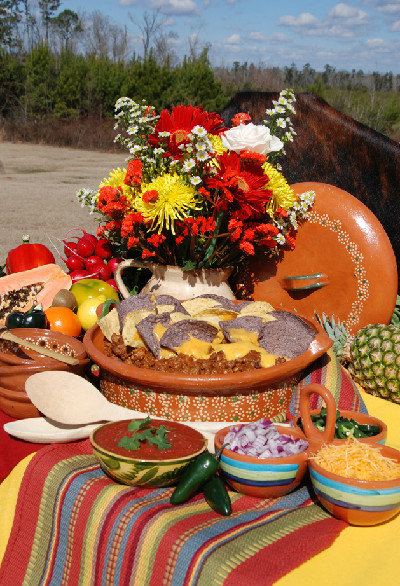
Lady Bird’s Texas Beef Chili
4 pounds chili meat (coarsely ground round steak or well-trimmed chuck)
1 large onion, chopped
2 cloves of garlic
1 teaspoon oregano
1 teaspoon cumin
6 teaspoons chili powder (or more)
2 cans (20 ounces each) tomatoes
2 to 6 generous dashes hot pepper sauce
Salt
2 cups hot water
1. Place meat, onion and garlic with 2 tablespoons of bacon fat in a large heavy skillet or Dutch oven. Cook until meat is light-colored.
2. Add remaining ingredients. Bring to a boil, lower heat and simmer uncovered about an hour. Skim fat during cooking.
3. If you like thicker stir in ¼ cup finely ground cornmeal.
4. Cover top with tortilla chips and cheese. Run under broiler to melt cheese.
5. Serve Texas-style with guacamole, jalapenos, cilantro and pico de gallo. Serves 10 to 12.
Mrs. Johnson gave this recipe to my mother, Mrs. Harris, in the 1960s. I can’t find a better chili recipe than this… Remember it’s always better the next day when all the spices blend!
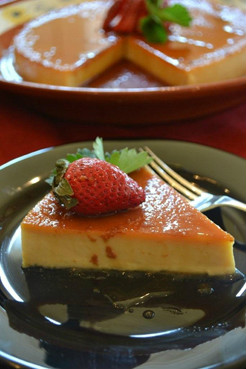
Flan Aurora
Equitrekking: How did you begin your international riding adventures?
Dawn Harris Brown: During my college years I attended the University of Madrid and studied art. I lived in a Spanish household, and I became involved in Spanish cuisine by learning from the family’s cook. Everyone laughed because I had brought my own bottle of Tabasco sauce along with my Mexican accent. I was in Spain, and now it was time to become a lady! My accent softened to Castilian, and I bought a pig-skin sidesaddle. I attended classes in the morning, cooked with our house cook Carolina at noon, and rode sidesaddle in the afternoon. In the cookbook, the “Bacalhau” and “Flan Aurora” recipes were adapted from Carolina’s kitchen.
Later, I moved to Andalusia in Southern Spain for almost four years. Every day during the tomato growing season we would have “Gazpacho Andaluz.” We lived in the small town of Morón de la Frontera, and gazpacho was the basic fare of Andalusian peasants. Tourists and the Spanish upper classes soon decided that the fabulous tastes should come out of the fields and into the restaurants. A neighboring farmer named Diego brought me seeds from his garden for incredible produce. He also raised pigs and taught me the process of curing a leg of jamón serrano, or Spanish ham.

Gazpacho Andaluz
The nearby town of Jerez de la Frontera was a center of Spanish riding schools. Some of the finest Andalusian horses are bred and trained in that area. The Spanish bullfighting horses are also trained there.
A Spanish friend, whose father owned several bull ranches in Andalusia, asked if I’d like to go with her on a distance ride from Jerez de la Frontera to the coastal town of Zahara de las Atunes and back to Jerez. Covering between 20 to 25 miles a day for 10 days, we rode through the White Towns of Andalusia and bull ranches to the beaches on the coast.
It was springtime, and all the magnificent wildflowers in the fields and mountains were as high as our horses’ chests. Galloping through the wildflower fields, in the hot sun and cool air, the horses’ hoofs clipped the flowers giving a rush of herbal scent. Residents from one of the mountain White Towns were picking wild asparagus in a mountain meadow when we came riding up to see what they were gathering. We joined in the picking for a fabulous omelet prepared that night at a small guest house in the town.
When we arrived on the coast, seafood was in order. A coastal bar boasted that it had the best paella. I told the owner that I was on a quest for the best paella myself. Let the culinary battle begin! My “Paella Aurora” (Aurora is my name in Spanish) is in the Spanish chapter of the cookbook, adapted for the home chef.
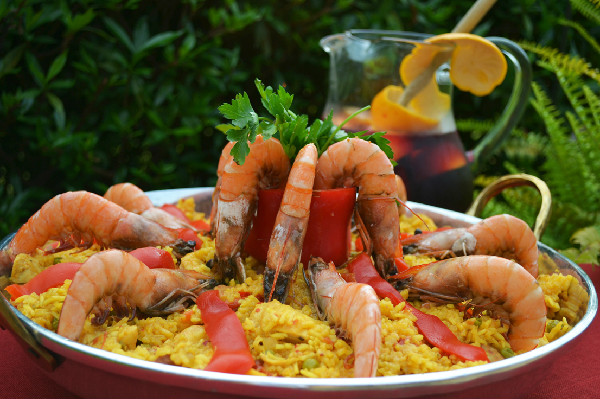
Paella Aurora
Equitrekking: What inspired you to ride through Hungary during the 1970s?
Dawn Harris Brown: One Sunday morning I was reading the New York Times classifieds and saw a small ad, “Horseback Riding in Hungary,” with a telephone number. I called and got the information, the date and where to meet. I flew to Budapest and found the small hotel meeting place, climbed onto an antique school bus along with a load of non-English speaking adventurers, and headed for the steppes of Hungary.
We arrived on the Hortobágy Puszta at an isolated barn full of green broke Hungarian Nonius horses. Our leader, who said he spoke English only none of the words made sentences, never bothered to qualify any of the riders’ abilities. We saddled up and took off at a gallop. I heard, “Whoa, you S.O.B.,” in seven different languages. Half of the riders decided this was not for them.
Hungary at the time was under communism, so we were riding through collective farms with no fences. The grasslands were grazed by spiral-horned sheep, cattle and buffalo. The Hungarian horsemen, called chicos, were some of the finest riders I’ve ever seen. They rode in small racing saddles with no girth. Try doing that! It gives a whole new meaning to “balanced riding.”
We stayed in old hunting lodges on the steppe. The hearty fare was noodles with pork fat and sugared crepes. Every meal was the same or a variation of the same, with no fruits or vegetables. The collective farms that edged the steppe grew rows of corn and vegetables. My young horse and I decided to partake of this bounty, since after all it did belong to the people (and horses). Standing on my saddle, I climbed apple trees to supplement my diet. By that time, my two-year-old horse was well broke and we were a team.
We finally reached the Romanian border, where our antique school bus met us for the return trip to Budapest. I wished I had room for that Hungarian colt in my suitcase. After a short train ride to Vienna, I indulged in fabulous Sachertortes and wiener schnitzels, and I included those recipes in the Austrian chapter of the cookbook.
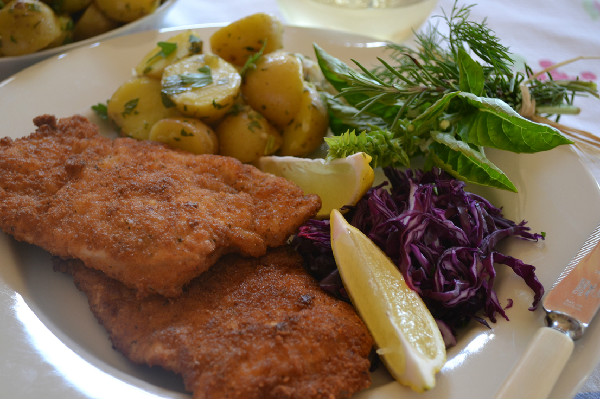
Wiener Schnitzel
Equitrekking: How did fox hunting become your passion?
Dawn Harris Brown: I pursued my interior design career back in New Orleans, Louisiana. A client from New York City asked if I would do some consulting work on a cottage she was renovating in Galway, Ireland. She asked if I fox hunted because she was a member of the Galway Blazers. Oh yes, I replied, I’d love to hunt! As I sat on the plane reading a how-to book on fox hunting, I realized this might be a baptism by fire. The basics were, “Stay in the back, keep your mouth shut, identify and don’t pass the field master, and don’t get in the way of the staff or crowd the hounds.” I’ve got it, I thought!
My first day out, we had fast and fabulous runs covering miles, and we jumped at least 100 walls. The fox hunting bug had infected me! After the wall country, we rode on to the banks and ditch country with the Scarteen Hunt Black and Tans in Limerick. If a visitor isn’t familiar with the ditches, I recommend just dropping the reins and letting the seasoned hunt horse do his job, since he knows more than you do!
I enjoyed hunting on the Irish Draughts and Irish Half-breds so much that when I returned to Louisiana I bought a King of Diamonds line stallion named Conor. I started to breed them, and I also cross them with Thoroughbred mares for Irish Sport Horse foals. Conor is now standing at stud as well as being fox hunted by Master Skip Crawford at the Potomac Hunt Club. Crawford’s picture and the “Hay Roasted Spring Lamb” recipe are in the Irish chapter of the cookbook.
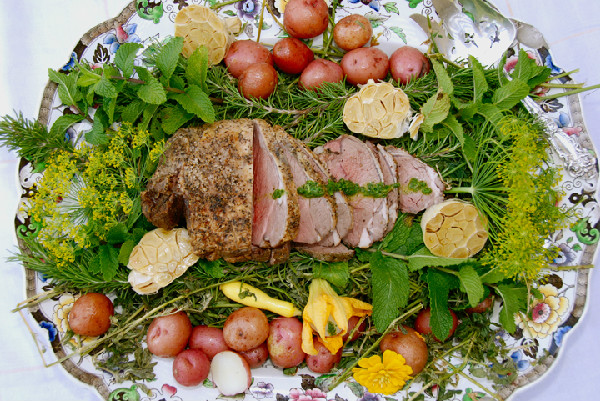
Hay Roasted Spring Lamb
Fox hunting became my passion, and food became my art form. I now hunt in Mississippi, Alabama and Georgia. When I’m at home, I also hunt for rabbit and coyote on foot every morning with my 12 lurchers, crossbred sighthound dogs.
For six seasons, I hunted with the Exmoor Foxhounds in Southwest England, dividing the week with the Quantocks Staghounds on the moors. The beautiful countryside was like galloping through a postcard.
One hunt in particular left a lasting image. Hunters had come to the meet out on Exmoor. The fog was too dense to cast the hounds, so we waited for it to lift. All you could hear were the house dogs from a Georgian farmhouse in a valley below and our hunt horses making impatient snorts in the fog. All of a sudden, the fog lifted like a curtain on a stage. The hillsides were dotted with mounted hunters. It was breathtaking. The hounds were cast and the hunt began.
Swinton Park in North Yorkshire was offering a game cookery course at the time, and of course my love of hunting and game cooking was a perfect match. All the game was raised and inspected on their 25,000 acres. We butchered and cooked fallow deer, pheasants, ducks, woodcock, grouse, hares and rabbits.
Equitrekking: What other regions have you visited, and what are some of the most memorable rides and meals you’ve had?
Dawn Harris Brown: A close friend had a house in the Loire Valley of France and asked me if I’d like to ride for a week. We went from farmhouse to château savoring the regional French cooking. One of the farmhouses we visited raised prize winning milk goats. Their cheve, or goat cheese, was unsurpassed.
Of course, attending a French cooking school was inevitable! The Dordogne area of France is known for their fowl recipes. Le château de Saussignac was located in a wonderful vineyard and offered a weeklong course. The game hen recipe in the France chapter was inspired by this experience.
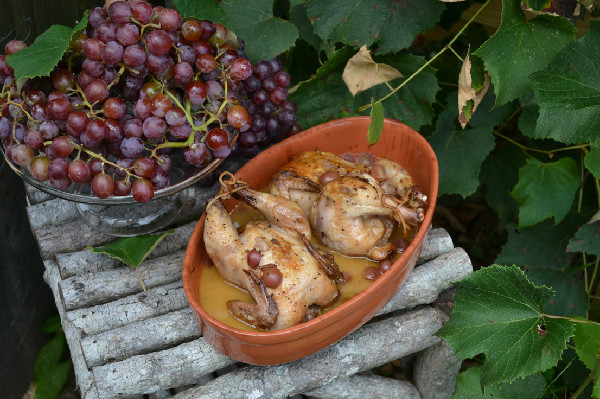
Vineyard Roasted Game Hens
My love of French food led me to Quebec to cook with chef Anne Desjardins at L'Eau à la Bouche and at the award-winning Relais & Chateaux, a hotel and restaurant.
Several riding trips have taken me to Costa Rica, the Llanos of Venezuela, Ecuador and Chile.
In Sydney, Australia, I took a continental cuisine cooking course with chef Tony Bilson. During the course, I met a friend who enjoyed riding as well as cooking. Let’s do a riding trip in the Snowy Mountains, we decided! We found an outfitter named Everett whose family had been some of the original settlers.
We rode through mountains and crossed the Snowy River while encountering mobs of kangaroos and herds of brumbies, or wild horses. Most of Everett’s horses were originally brumbies that he had caught and trained for riding. Flocks of cockatoos robbed our horses’ feed. They are a beautiful nuisance to all the farmers and ranchers. One night, a filly had come into our camp and decided to stay. She followed us for a week. Later I asked Everett what had happened to her, and he said she is now one of his best riding horses.
Equitrekking: How did you end up riding though Mongolia?
Dawn Harris Brown: In the early 1990s, two Montana adventurers asked me if I would like to join them on an exploratory ride in Outer Mongolia. The year before they had planned another ride to Inner Mongolia, but China was closed because of the Tiananmen Square unrest. One thing about these rides is to always expect the unexpected! For Outer Mongolia, it was a go. I had a design project being made in Beijing at the time, so the plan was to meet in Beijing and fly to the Mongolian capitol city of Ulan Bator.
I had prepared myself by reading everything I could on Mongolia. I admire Roy Chapman Andrews, an early director of the American Museum of Natural History and the discoverer of dinosaur eggs in the Gobi Desert during the 1930s. Andrews was the prototype for the movie character Indiana Jones, and he was truly my hero. I have the full collection his books. Across Mongolian Plains was a big influence on my life.
As far as I know, we were the first Westerners to ride this route in search of the reindeer people, nomadic herders who range between Outer Mongolia and Siberia. To start the ride, the Mongolian wrangler ran his herd of horses from the mountain grazing land past our inspecting eyes. Each of us picked one, as kind of a “driveby pickin’”!
I had read that Mongolia had neither food nor fuel after the Russians left, so I kept that in mind. I brought my own tack, a synthetic saddle, bridle and girth, which I traded at the end to our wrangler for his handmade Mongolian saddle. I also had a saddle pad made with water bottle pockets on the front and big pockets on the back with Velcro ties to hold my dry clothes and raincoat. I was a travelin’ unit.
.jpg)
Dawn Brown traded her tack for a Mongolian saddle.
The Mongolian diet consisted of sheep and goats on the hoof that followed along behind us. One was butchered every night and boiled in a big pot over the fire. “There goes Hal,” I would think. I quit naming them after the first night.
I had also read about the pristine rivers and lakes on the grasslands. I brought a hand fishing hook and line to catch taimen trout, which were plentiful in the lakes. The Mongolians didn’t eat fish, but part of my important carry-on gear was my Cajun fish fry spice. We caught a big trout. I filleted it right then and there, rolled it in my fish fry, and had the best fried fish I’ve eaten to this day. The Westerners were delighted, but the Mongolians went back to their mutton.
The season was September. The blueberries and rhubarb were still plentiful, and we mixed them with rich yak yogurt — yum! We stayed in a nomadic hut called a ger. Another interesting thing is the culinary custom of smearing the yogurt on top of ger’s felt roofs to dry and then breaking it up like chips. It was a very good snack.
We finally came upon some reindeer people. They were cutting hay in the lower meadows for the winter reindeer feed. They said the village was a two-day ride away. One of the reindeer people spoke some Mongolian, so our interpreter could communicate somewhat. When we arrived in camp, it was raining sideways, and there were gale winds. I tied my horse up to one of the reindeer stakes and started putting up my tent. A young mother saw my struggle and ushered me into her teepee-style tent. She motioned me to take off my wet clothes and wrapped me in a warm reindeer hide. Reindeer milk tea and dried meat never tasted so good!
I’ve found that the more you travel, the more people are alike. They have families, aging parents, health issues and day-to-day struggles. The connection with and concern for another human being is an international language. The sparse population of the Mongolian grasslands always welcomes a traveler or guest with tea and food on the ger’s stove, open and welcoming to everyone. The loneliness of the grasslands is reflected in their music, which expresses the soul of the people.
Equitrekking: Tell us about your new cookbook. How does it allow you to connect what you love best?
Dawn Harris Brown: Stable to Table Menu Cookbook was a passion project that sprang from my own lifestyle. The international language of horses and food is the same all over the world, and in my mind it was a natural match. Each country is unique in their horse breeds and food, so I really can’t pick an absolute favorite. I loved them all. I’m still fox hunting and rabbit and coyote hunting with my lurchers, along with cooking for friends and family. I plan to do more riding and cooking adventures in more countries. I also have more cookbooks with a horse theme coming in the near future.
Contact Dawn Harris Brown and learn more about the Stable to Table Menu Cookbook at www.stabletotablecookbook.com.
Karen Braschayko is a freelance writer and horse lover who lives in Michigan.




